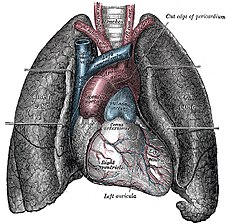Lung

The lung is an organ belonging to the respiratory system and interfacing to the circulatory system of air-breathing vertebrates. Its function is to exchange oxygen from air with carbon dioxide from blood. The process in which this happens is called "external respiration" or breathing. There are also nonrespiratory functions of the lungs. Medical terms related to the lung often start in pulmo- from the Latin word pulmones for lungs.
Mammalian lungs
The lungs of mammals have a spongy texture and are honeycombed with epithelium having a much larger surface area in total than the outer surface area of the lung itself. The lungs of humans are typical of this type of lung.
Breathing is largely driven by the diaphragm below, a muscle that by contracting expands the cavity in which the lung is enclosed. The rib cage itself is also able to expand and contract to some degree.
As a result, air is sucked into and pushed out of the lungs through the trachea and the bronchial tubes or bronchi; these branch out and end in alveoli which are tiny sacs surrounded by capillaries filled with blood. Here oxygen from the air diffuses into the blood, where it is carried by hemoglobin.
The deoxygenated blood from the heart reaches the lungs via the pulmonary artery and, after having been oxygenated, returns via the pulmonary veins.
Location
The lungs are located inside the thoracic cavity, protected by the bony structure of the rib cage and enclosed by a double-walled sac called pleura. The inner layer of the sac adheres tightly to the outside of the lungs and the outer layer is attached to the wall of the chest cavity. The two layers are separated by a thin space called the pleural cavity that is filled with pleural fluid; this allows the inner and outer layers to slide over each other, and prevents them from being separated easily.
Evolutionary origins
The lungs of vertebrates are closely related (i.e. homologous) to the swim bladders of fish (but not to their gills). The evolutionary origin of both are thought to be outpocketings of the upper intestines. This is reflected by the fact that the lungs of a fetus also develop from an outpocketing of the upper intestines (see ontogeny and phylogeny). The article on swim bladders contains further details about the evolutionary origin of these two organs.
Arachnid lungs
Spiders have structures called "book lungs", which are not evolutionarily related to vertebrate lungs but serve a similar respiratory purpose.
Nonrespiratory functions of the lungs
In addition to respiratory functions such as gas exchange and regulation of hydrogen ion concentration, the lungs also:
- influence concentration of biologically active substances in arterial blood
- filter out small blood clots formed in the systemic veins
- serve as a physical layer of soft, shock-absorbent protection for the heart, which the lungs flank and nearly enclose.
See also
External links
- Dr D.R. Johnson: Introductory anatomy, respiratory system
- Franlink Institute Online: The Respiratory System
- Lungs OnLine
- Lungs 'best in late afternoon'
Also, lung (龍) is the generic Chinese name for a dragon.
